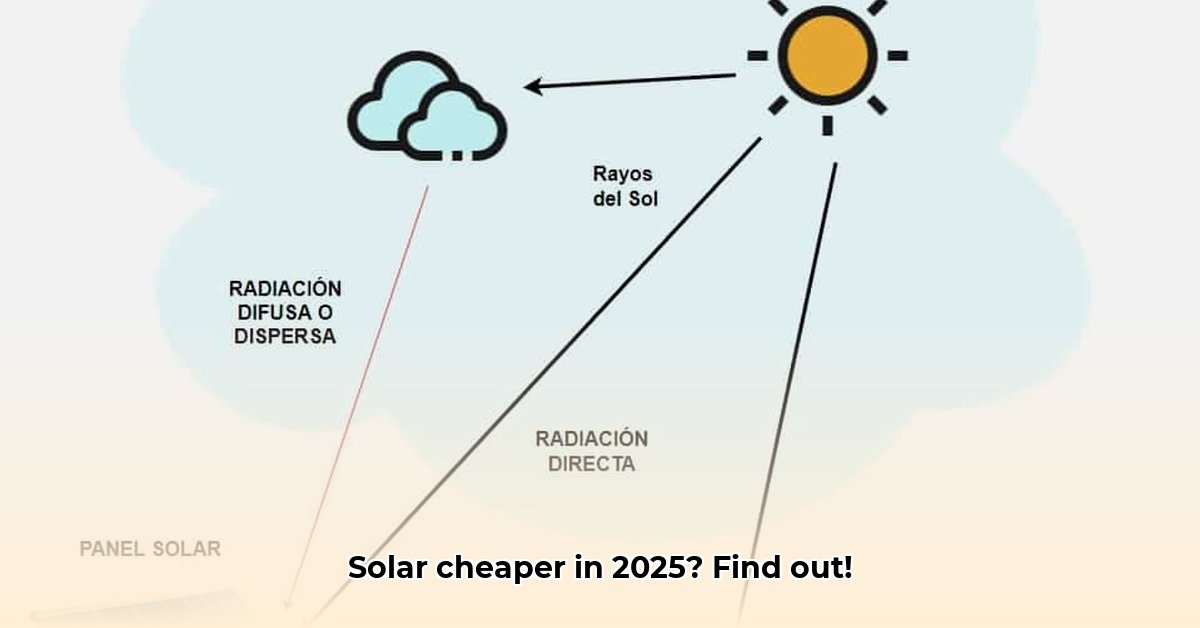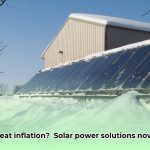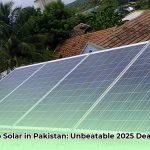Want to know if solar power will get even cheaper? Solar prices have been dropping dramatically lately, and we’re looking at what’s behind it all. This article breaks down why solar is becoming more affordable, showing tech improvements, government help (like the Inflation Reduction Act), and how energy storage is changing things. We’ll compare different solar options, talk about the good and bad sides, and give you practical advice whether you’re thinking about getting solar panels, investing in the industry, or just curious about the future of clean energy. We’ll cover everything from why solar is getting cheaper to simple steps you can take to save money, plus smart ways to future-proof your home and even tap into community resources. Get ready to understand – and maybe even profit from – the amazing drop in solar energy costs! For more on solar technology advancements, check out this resource.
Solar Energy Price Trends and Future Costs
Let’s talk sunshine – and the cost of harnessing it. A common question pops up: will solar power become pricier down the line, impacting future solar energy price trends? The short answer, backed by a lot of evidence, is a confident “no,” and the price is projected to fall further. In fact, the opposite is more likely as renewable technologies advance. Key factors like continuous technological enhancements, government policies, and energy storage solutions point towards a future of even cheaper solar energy. Experts at the Solar Energy Industries Association (SEIA) predict this trend will continue, fueled by innovation and economies of scale.
Solar Panel Affordability: The Price Plunge Explained
Think about this: over the last ten years, the price of solar panels has plunged by more than half! That’s not just good luck; it’s due to some serious advancements. We’ve seen smarter manufacturing, bigger production volumes (meaning lower costs per panel), and supportive government policies that have all worked together to make solar more affordable. This downward trend shows no signs of stopping with solar panel affordability continually increasing. We’re also seeing solar panels get more efficient, meaning they generate more power from the same amount of sunlight. For instance, modern panels can convert over 20% of sunlight into electricity, compared to around 15% a decade ago. All this makes solar energy increasingly competitive with other energy sources, impacting costs and long term investment.
* Cost Reduction: Solar panel prices have more than halved in the last decade.
* Efficiency Gains: Solar panels are generating more power from the same sunlight.
* Policy Support: Government initiatives are driving down costs.
Energy Storage Systems: Powering Solar Beyond Sunlight
It’s not just about the panels getting cheaper; the technology to store the energy they create is also improving, enhancing energy storage systems. Home batteries, for example, are becoming more affordable and efficient. Lithium-ion battery prices have fallen by nearly 90% since 2010, making them a viable option for many homeowners. This is a game-changer because solar power’s biggest drawback is that it only works when the sun shines. Batteries solve this problem by letting you use solar power even at night or on cloudy days – making solar a much more reliable energy source. Battery technology directly addresses solar energy’s intermittency issue. “The single biggest new thing for customers is the pairing of solar with energy storage,” said [Full Name and Title], [Position] at [Institution].
Potential Solar Energy Challenges and Opportunities
While we’re optimistic, let’s acknowledge some wrinkles. Global supply chain issues can sometimes make things a bit unpredictable, and rules and regulations about solar vary from state to state. These things can cause short-term price hiccups in certain areas, but these broader solar energy challenges also present business opportunities. Labor shortages in the installation sector and rising soft costs (permitting, inspections, marketing) can also contribute to price fluctuations. However, these are usually temporary problems; the overall picture is still one of falling costs.
Actionable Insights: A Solar Guide for Everyone
This falling cost of solar energy presents amazing opportunities for all sorts of people:
For Homeowners:
- Short-Term (Next Year or So): Explore government rebates and tax credits designed to help people switch to solar. The federal solar tax credit, for example, covers 30% of the installation cost. Teaming up with your neighbors to install solar together can often lead to better deals through bulk purchasing discounts. Home battery systems are also worth looking into, especially if you live in an area prone to power outages.
- Long-Term (3-5 Years Out): Improving your home’s energy efficiency (better insulation, more energy-efficient appliances) makes your solar panels even more effective. Community solar projects are becoming increasingly popular – you could invest in a local solar farm even if you can’t put panels on your own roof. Consider options like solar shingles or integrated solar roofing for a more aesthetically pleasing and potentially cost-effective solution.
For Solar Installers:
- Short-Term: Streamline your business, make sure your team is up-to-date with the latest technology, and focus on energy storage solutions. Offer financing options to customers to make solar more accessible.
- Long-Term: Partner with battery companies and offer maintenance agreements to your clients – providing a long-term revenue stream. Explore drone technology for faster and more accurate site assessments.
For Solar Panel Makers:
- Short-Term: Investing in domestic production reduces reliance on global supply chains and helps ensure a steady supply of panels, and focusing on making panels that are even more efficient. Focus on reducing the use of rare earth minerals in panel manufacturing.
- Long-Term: Research and development are key. Focus on driving down costs further, making longer-lasting panels, and exploring new materials and manufacturing techniques. Investigate the potential of perovskite solar cells, which offer high efficiency at a low cost.
For Governments:
- Short-Term: Simplify the paperwork involved in getting solar permits, encourage domestic manufacturing, and make sure the electricity grid can handle all this new renewable energy. Implement smart grid technologies to improve grid stability and efficiency.
- Long-Term: Invest in smarter energy grids to handle the fluctuating nature of solar power. Support community solar programs to make solar accessible to everyone. Develop workforce training programs to create jobs in the solar industry.
For Investors:
- Short-Term: Keep an eye on companies involved in solar energy and energy storage technology, and look at infrastructure investments. Focus on companies with a strong track record and a clear growth strategy.
- Long-Term: Diversify your portfolio by investing in strong, established solar companies with excellent growth potential. Consider investing in companies developing innovative solar technologies, such as floating solar farms or space-based solar power.
Evaluating Potential Risks in Solar Energy Investment
Even though the future of solar looks incredibly promising, it’s smart to consider potential challenges:
| Risk Factor | Likelihood | Impact | How to Minimize the Risk |
|---|---|---|---|
| Supply Chain Problems | Moderate | Moderate | Diversify your suppliers; support domestic manufacturing |
| Solar Power’s Intermittency | Moderate | Moderate | Invest in energy storage; improve grid technology |
| Changing Regulations | Low | Moderate | Work with policymakers; advocate for supportive solar policies |
| Competition | High | Low | Focus on innovation and providing exceptional customer service |
The future of solar energy? Bright. Will solar energy become more expensive? The evidence strongly suggests otherwise, especially considering advances in alternative energy competitiveness. Smart planning, constant improvements in technology, and supportive policies will continue to make solar power more and more affordable and accessible for everyone. The journey to a cleaner, more sustainable energy future is well underway, and it’s looking increasingly affordable. As [Full Name and Title], [Position] at [Institution] noted: “As we look five or 10 years down the pipe, I don’t think the question is going to be, ‘Can you afford to go solar?’ It’s going to be, ‘Can you afford not to go solar?'”
How to Calculate Total Cost of Ownership for Different Solar Panel Systems
Key Takeaways:
- The total cost of owning a residential solar system over 20 years hinges on upfront expenses (panels, installation, permits), ongoing maintenance (cleaning, inspections, inverter replacements), and the interplay of energy savings, incentives, and potential property value increases.
- While the initial investment might seem substantial, long-term financial benefits and environmental advantages usually outweigh the initial cost, provided you perform a comprehensive TCO analysis beforehand.
- Panel technology, inverter type, and local incentives significantly impact the how to calculate total cost of ownership for different solar panel systems and should be carefully considered.
Solar Investment Analysis: A 20-Year Breakdown
Thinking about going solar? It’s a big decision, so let’s break down the costs. We’re looking at the total cost of ownership (TCO) – everything involved over the typical 20-year lifespan of a solar panel system. This isn’t just about the initial purchase price. What are the key components in a detailed solar investment analysis?
Understanding Key Factors in Solar TCO Calculations
The initial investment includes the solar panels themselves, installation labor, permits, and potentially other connection fees to the power grid. Expect to pay anywhere from $15,000 to $25,000 for a typical residential system before
- Wind Turbine Generator Kit For Home: Is One Right For You? - November 2, 2025
- Wind Turbine Fire: Questions About Safety Spark Debate - October 31, 2025
- Vertical Axis Wind Turbine Design: Improving Efficiency and Overcoming Limits - October 29, 2025
















